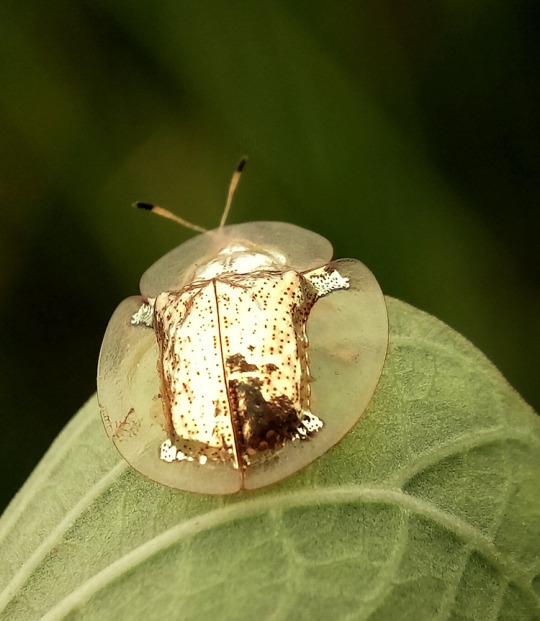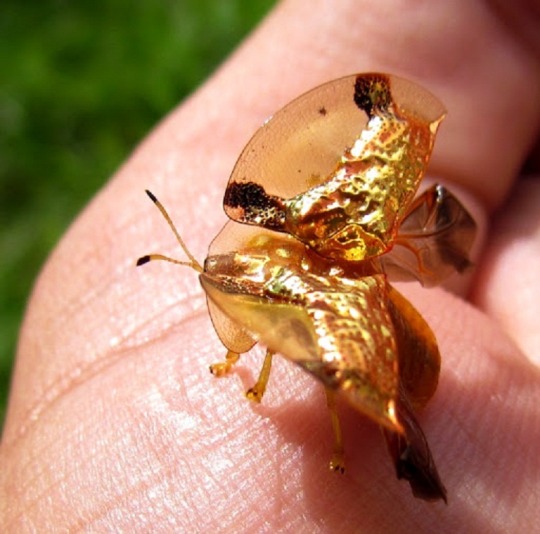#Charidotella
Text


Bug of the Day
I was so psyched that I managed to successfully rear this Golden Tortoise Beetle (Charidotella sexpunctata) from a wee larvae with a gross poop hat (fecal shield) to this rad red sports car! And then I realized that I forgot to get baby photos, so you will just have to imagine a flat but spiky larva covered with its own waste. Or Google it :-)
#Golden Tortoise Beetle#Charidotella sexpunctata#Charidotella#Chrysomelidae#Coleoptera#beetle#tortoise beetle#insect#bug of the day#BotD#fecal shield#poop hat#frass
443 notes
·
View notes
Text
الخنفساء الذهبية المدرعة
الخنفساء الذهبية المدرعة
0 notes
Note
I’m going around tumblr and asking entomologists and bug bloggers what their favorite bug is. What’s your favorite bug?
off the top of my head, my answer is usually the golden tortoise beetle, Charidotella sexpunctata!

#golden tortoise beetle#Charidotella sexpunctata#Chrysomelidae#leaf beetle#coleoptera#arthropods#insects#asked and answered
100 notes
·
View notes
Text
Animal of the Day!
Golden Tortoise Beetle (Charidotella sexpunctata)

(Photo by Yusuf Kurnia)
Conservation Status- Unlisted
Habitat- North America
Size (Weight/Length)- 7 mm
Diet- Leaves
Cool Facts- Known as a blight to sweet potatoes and morning glories, the golden tortoise beetle is a beautiful pest. It might be surprising to hear that despite these beetles’ brilliant sheen, they are master camouflagers. The golden color comes from pockets of fluid reflecting sunlight within its exoskeleton. When startled, the golden tortoise beetle stops looking so golden and turns the fluid a dark red instead. Even if that doesn’t work, the beetle then plays dead with the hope that a hungry bird will avoid eating a dead insect. The clear elytra surrounding the beetle keeps its softer wings safe and prepared for flight as a last resort option to flee.
Rating- 11/10 (Not a pest in my heart.)
#Animal of the day#Animals#Insects#Beetles#Monday#May 22#Golden tortoise beetle#biology#science#conservation#the more you know#cw: insects
639 notes
·
View notes
Text

Charidotella sexpunctata, the golden tortoise beetle, is a species of beetle in the leaf beetle family, Chrysomelidae
#dishwasher draws#wormblr#parahumans#worm#fanart#worm wildbow#worm web serial#taylor herbert#skitter worm#weaver worm#taylor worm#post work doodle#fuckign around with colours again#taylor herbert youll always be famous#every skitter drawing you will get bug facts bc i also have bug autism
98 notes
·
View notes
Note
whats ur favorite beetle? 🪲
Rungo Bungo
no really, there are so many kinds of beetles I get lost, but if I had to choose one, it would be Charidotella sexpunctata (hehe sex) which not only looks amazing on its golden form, but also can change colors. I saw this live a few times.
Here you can see it on its golden form

and here on it's reddish form, note that the cuticle is partially changing color. It apparently dehydrates it and rehydrates it to keep a reflective coat. Amazing bug.

14 notes
·
View notes
Text
Back on my hyperfixation shenanigans so I have not slept and here's a list of what I consider to be the prettiest beetles, butterflies and moths, damselflies, and grasshoppers and crickets that inhabit Colorado and Kentucky according to insectidentification.org :
COLORADO
Emerald ash borer (Agrilus planipennis)
Fifteen-spotted lady beetle (Anatis labiculata)
Golden tortoise beetle (Charidotella sexpunctata)
Knapweed root weevil (Cyphocleonus achates)
Longhorn beetle (Semanotus amethystinus)
Dogbane Leaf Beetle (Chrysochus auratus)
European Ground Beetle (Carabus nemoralis)
Golden Net-wing Beetle (Dictyoptera aurora)?
Margined Blister Beetle (Epicauta funebris)
May Beetle - P. lanceolata (Phyllophaga lanceolata)
Mottled Tortoise Beetle (Deloyala guttata)
Pleasing Fungus Beetle (Gibbifer californicus)
Poplar Borer Beetle (Saperda calcarata)
Shining Leaf Chafer - Anomala spp. (Anomala spp.)
Signate Lady Beetle (Hyperaspis signata)
American Lappet Moth (Phyllodesma americana)
Cinnabar Moth (Tyria jacobaeae)
Common Checkered-Skipper (Pyrgus communis)
Glover's Silkmoth (Hyalophora columbia gloveri)
Great Ash Sphinx Moth (Sphinx chersis)
Autumn Meadowhawk (Sympetrum vicinum)
Black Saddlebags Skimmer (Tramea lacerata)
Bird Grasshopper (Schistocerca spp.)
Obscure Bird Grasshopper (Schistocerca obscura)
Sooty Longwing Katydid (Capnobotes fulginosus)
KENTUCKY
Andrew's Snail-eating Beetle (Scaphinotus andrewsii)
Black Firefly (Lucidota atra)
Calligrapha Beetle (Calligrapha spp)
Eastern Hercules Beetle (Dynastes tityus)
Emerald Euphoria Beetle (Euphoria fulgida)
Glowworm (Phengodes spp.)
Goldsmith Beetle (Cotalpa lanigera)
Metallic Wood-boring Beetle: Chalcophora (Chalcophora fortis)
Notched-mouth Ground Beetle (Dicaelus purpuratus)
One-spotted Tiger Beetle (Apterodela unipuncata)
Rainbow Darkling Beetle (Tarpela micans)
Rainbow Scarab Beetle (Phanaeus vindex)
Six-spotted Tiger Beetle (Cicindela sexguttata)
Southern Sculptured Pine Borer Beetle (Chalcophora georgiana)
Stag Beetle (Lucanus capreolus)
Twice-stabbed Lady Beetle (Chilocorus stigma)
Vietinghoff's Ground Beetle (Carabus vietinghoffii)
Abbott's Sphinx Moth (Sphecodina abbottii)
American Ermine Moth (Yponomeuta multipunctella)
Arched Hooktip (Drepana arcuata)
American Bird's-Wing Moth (Dypterygia rozmani)
Arcigera Flower Moth (Schinia arcigera)
Attentive Crocus Moth (Xanthotype attenuaria)
Basswood Leafroller (Pantographa limata)
Beautiful Wood-Nymph (Eudryas grata)
Black-waved Flannel Moth (Megalopyge crispata)
Blackberry Looper (Chlorochlamys chloroleucaria
Blinded Sphinx Moth (Paonias excaecata)
Bluish Spring Moth (Lomographa semiclarata
Buck Moth (Hemileuca maia)
Carmine Snout Moth (Peoria approximella)
Carrot Seed Moth (Sitochroa palealis)
Cecropia Silk Moth (Hyalophora cecropia)
Changeable Grass-Veneer (Fissicrambus mutabilis)
Colorful Zale (Zale minerea)
Common Lytrosis Moth (Lytrosis unitaria)
Confused Eusarca (Eusarca confusaria)
Cross-lined Wave (Timandra amaturaria)
Curve-toothed Geometer (Eutrapela clemataria)
Dark-banded Geometer (Ecliptopera atricolorata)
Deep Yellow Euchlaena (Euchlaena amoenaria)
Diaphania costata (Diaphania costata
Dimorphic Macalla (Epipaschia superatalis)
Dot-lined White (Artace cribrarius)
Dotted Gray (Glena cribrataria)
Drab Prominent (Misogada unicolor)
Eight-spotted Forester Moth (Alypia octomaculata)
Elder Shoot Borer (Achatodes zeae)
Explicit Arches (Lacinipolia explicata)
Eyed Paectes Moth (Paectes oculatrix)
Falcate Orangetip (Anthocharis midea) (female)
Fall Webworm (Hyphantria cunea)
False Crocus Geometer (Xanthotype urticaria
Fervid Plagodis (Plagodis fervidaria)
Fig Sphinx (Pachylia ficus)
Friendly Probole Moth (Probole amicaria)
Giant Leopard Moth (Hypercompe scribonia)
Goldcap Moss-eater Moth (Epimartyria auricrinella)
Gray-edged Hypena (Hypena madefactalis)
Green Arches (Anaplectoides prasina)
Hag Moth (Phobetron pithecium
Hibiscus Leaf Caterpillar Moth (Rusicada privata)
Imperial Moth (Eacles imperialis)
Lesser Maple Spanworm Moth (Speranza pustularia
Luna Moth (Actias luna)
Melissa Blue Butterfly (Plebejus melissa spp.)
Modest Sphinx Moth (Pachysphinx modesta)
Morbid Owlet Moth (Chytolita morbidalis)
Orange-patched Smoky Moth (Pyromorpha dimidiata)
Pale Beauty (Campaea perlata)
Pale Lichen Moth (Crambidia pallida)
Pale Metarranthis (Metarranthis indeclinata)
Pandorus Sphinx Moth (Eumorpha pandorus)
Parthenice Tiger Moth (Apantesis parthenice)
Pearly Wood-Nymph Moth (Eudryas unio)
Pero Moth (Pero spp.)
Pink-patched Looper (Eosphoropteryx thyatyroides)
Pipevine Swallowtail (Battus philenor)
Pistachio Emerald Moth (Hethemia pistasciaria)
Plebeian Sphinx Moth (Paratrea plebeja) (Caterpillar)
Primrose Moth (Schinia florida)
Promiscuous Angle Moth (Macaria promiscuata)
Raspberry Pyrausta (Pyrausta signatalis)
Rustic Sphinx Moth (Manduca rustica)
Saddleback Caterpillar Moth (Acharia stimulea)
Saddled Yellowhorn (Colocasia flavicornis)
Salt-and-pepper Looper Moth (Syngrapha rectangula)
Satin Moth (Leucoma salicis)
Scarlet-winged Lichen Moth (Hypoprepia miniata)
Schlaeger's Fruitworm Moth (Antaeotricha schlaegeri)
Showy Emerald Moth (Dichorda iridaria)
Small Bird Dropping Moth (Ponometia erastrioides)
Snowy Urola (Urola nivalis)
Sorghum Webworm Moth (Nola cereella)
Southern Flannel Moth (Megalopyge opercularis)
Southern Longhorn Moth (Adela caeruleella)
Southern Pine Sphinx (Lapara coniferarum)
Southern Tussock Moth (Dasychira meridionalis)
The Badwing (Dyspteris abortivaria)
Unspotted Looper Moth (Allagrapha aerea)
Venerable Dart Moth (Agrotis venerabilis
Vine Sphinx Moth (Eumorpha vitis)
Walnut Sphinx Moth (Amorpha juglandis)
Wavy-lined Emerald Moth (Synchlora aerata)
Western Grapeleaf Skeletonizer Moth (Harrisina metallica)
White Flannel Moth (Norape ovina)
White Slant-line Moth (Tetracis cachexiata)
White-fringed Emerald Moth (Nemoria mimosaria)
Yucca Moth (Tegeticula, Greya, and Prodoxus spp.)
Carolina Locust (Dissosteira carolina)
Eastern Shieldback Katydid (Atlanticus spp.)
Slender Meadow Katydid (Conocephalus fasciatus)
True Katydid (Pterophylla camellifolia)
Ebony Jewelwing (Calopteryx maculata)
Midland Clubtail (Gomphurus fraternus)
Red Saddlebags (Tramea onusta)
Seepage Dancer (Argia bipunctulata)
5 notes
·
View notes
Note
Sexiest bug in wicked's rest?
Finally! Someone asking the important questions. That’s an easy one - dryocampa rubicunda, commonly known as the rosy maple moth. Or if the bold colors don’t do it for ya, then I’d say charidotella sexpunctata aka the golden tortoise beetle. Two absolute stunners!
6 notes
·
View notes
Photo

Gemza - Charie Dotela (she/her)
Charie Dotela - derived from “charidotella”, a genus of turtle beetles
A cutie, obsessed with creepy crawlies
Knows about every insect in alternia
When not obsessing over insects, she’s doing good work in online schooling
18 notes
·
View notes
Text
today i learned about the golden tortoise beetle, charidotella sexpunctata

it can change colors!!! in a cool ass color scheme!!!!!! doesn’t this beetle look like it’s wearing an incredibly painstaking makeup look. with expensive glitter

[image text: Their ability to adjust the reflectivity of their shell is very different from other animals—such as chameleons and squid—that change color via expanding and contracting pigment cells in their skin. Their exoskeleton acts as a sort of portable mirror using liquid, changing color via nano-sized channels that control fluid levels in the layers under their shell. When moisture fills these channels, the layers of the shell become smooth and evenly reflect light for a mirrored effect. When stressed, the beetle dries up that fluid, diminishing the mirror-like properties and revealing the base red pigment beneath. The researchers liken this ability to “a switchable reflector.”]
3 notes
·
View notes
Text

Golden Tortoise Beetle (Charidotella sexpunctata)
May 28 2022
Showing off its gold color and translucency! Fun fact: tortoise beetles change their color from gold, to brown, and even spotted.
Native
15 notes
·
View notes
Text

A golden tortoise beetle
Also known as Charidotella Sexpunctata, it is part of the leaf beetle family, Chrysomelidae and a native to the Americas.
7 notes
·
View notes
Video
The Golden Turtle Beetle (Charidotella sexpunctata) is a widespread insect in North America with a typical size of 5-7 millimeters. These beetles are recognizable for their golden coloration, but they also have the ability to change colors whenever they need to. This change is due to microscopic valves that control humidity levels. https://www.instagram.com/p/CgYjj7fIZnG/?igshid=NGJjMDIxMWI=
2 notes
·
View notes
Text
Este é o Besouro Tartaruga Dourado (ou Charidotella sexpunctata, anteriormente também conhecido como Metriona bicolor). O nome vem da sua capacidade de mudar de cor, de um tom avermelhado para um outro dourado e vice-e-versa. Já o “tartaruga” no nome, vem do visual da sua couraça, que lembra bem o casco de uma tartaruga.
Os Besouros Dourados, como são chamados popularmente, são norte-americanos e podem ser encontrados facilmente nas folhas da Corriola, plantas das quais se alimentam. Os besouros dourados possuem a capacidade de alterar a refletividade da cutícula para camadas externas mais claras, o que seria como tornar uma joaninha avermelhada para uma dourada. A pigmentação dourada aumenta e os pontinhos pretos, típicos de uma joaninha, ficam menores ou ganham um aspecto singular.
Boa tarde! Lucas Lima
0 notes
Text



Golden Tortoise Beatle (Charidotella bicolor)
Found in eastern North America
Associated with sweet potatoes and morning glory
Sources
0 notes
Text
Saturated Beetle Tuesday #1: Golden Tortoise Beetle

The Golden Tortoise Beetle, Charidotella sexpunctata, or “goldbug” is a species of beetle best known for their bright golden color and protruding translucent rim, which can be seen in many different species of Tortoise Beetles. It is native to North America and can be found largely in the east extending to parts of Iowa and Texas. They are quite small and tend to be around 1/4 of an inch, generally ranging from 5.0mm to 7.0mm. They feed on the leaves of Sweet Potato plants, Morning Glory, and Bindweed along with other plants in the Convulvulaceae family. Their eggs are flattened and oval shape and are often stuck to the bottoms of leaves. Their larvae are shell-less and pinkish brown in color the have a ring of spike-like protrusions of the sides of their body (Gross Fun Fact: The larvae tend to make shields out of their own poop)
Anyway thank you for reading and have a great Saturated Beetle Tuesday!
1 note
·
View note